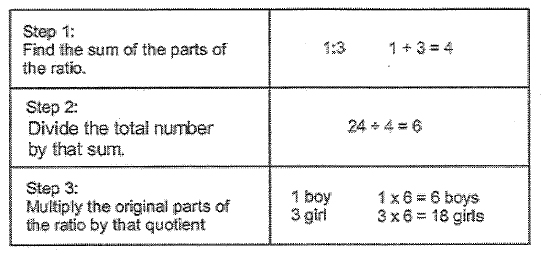We now know what a ratio is. In a class, there are 3 girls for every boy. If I were to ask what the ratio of boys to girls is, the answer would be 1:3. This ratio is in simplest form, so it doesn’t tell us exactly how many boys or girls there are. Let’s say we have 24 students in the class, and the ratio of boys is 1:3, how would we figure out exactly how many boys and girls there are? We need to change our ratio to an equivalent ratio where the parts of it (the boys and girls) equal the total of 24 students.
Right now, we have 1:3, which equals 4. One way we could do this is to just continue to increase the ratio until it equals 24. Multiplied by 2, it would be 2:6, which equals 8. By 3 is 3:9, which is 12. By 4 is 4:12, which is 16. By 5 is 5:15, which is 20. Finally, by 6 is 6:18, which is 24. This process could get very long depending on how far we need to multiply. There is an easier way.
Follow these steps:
 These steps would work in any scenario. Lets say there are 144 animals in a zoo. The ratio of birds to mammals is 1:2. How many of each animals are there?
These steps would work in any scenario. Lets say there are 144 animals in a zoo. The ratio of birds to mammals is 1:2. How many of each animals are there?
Step 1: 1+2=3
Step 2: 144 ÷ 3 = 48
Step 3: 1 x 48 = 48, 2 x 48 = 96
There are 48 birds and 96 mammals.
